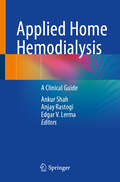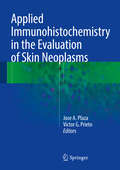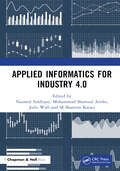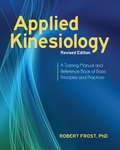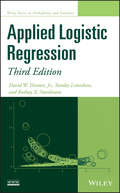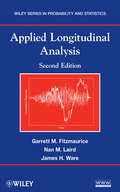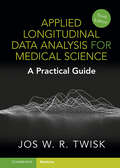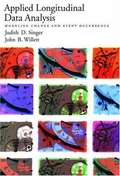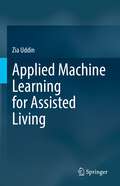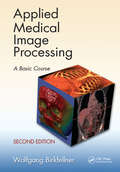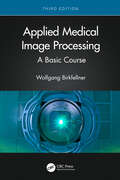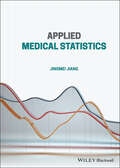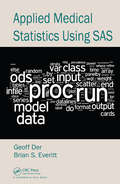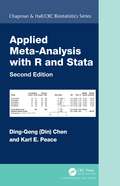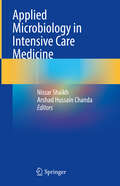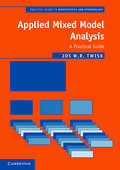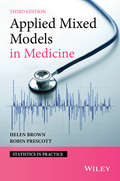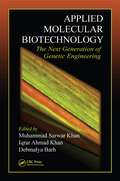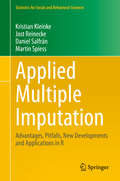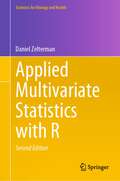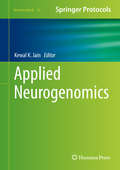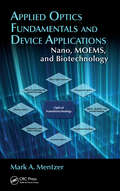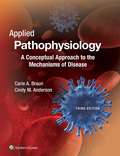- Table View
- List View
Applied Home Hemodialysis: A Clinical Guide
by Edgar V. Lerma Ankur Shah Anjay RastogiThis book is a comprehensive reference to home dialysis. There is a great need for this resource, which spans the spectrum of learners from the medical student to the well-practiced attending physician. Recent texts that have been authored on the topic have focused on peritoneal dialysis, but often home hemodialysis is limited to a single chapter in a work on dialysis. This book addresses this gap and provides instruction on the rapidly expanding field of home hemodialysis for all levels of nephrologists. The topics covered in this book include a survey of currently available technology, management of various complicating conditions, home hemodialysis program development, and patient training and home preparation. All chapters follow a consistent, easy-to-follow structure, which features a case presentation, didactics, and a visual abstract. Written by experts in the field, this book is both a didactic and bedside reference for the practicing nephrologist.
Applied Immunohistochemistry in the Evaluation of Skin Neoplasms
by Victor G. Prieto Jose A. PlazaThis book provides a comprehensive, state-of-the-art account of the role of immunohistochemistry in the diagnosis of skin tumors, which is crucial given that overlapping histologic features and unusual morphologic changes can lead to considerable diagnostic uncertainty. The book reviews in detail the sensitivity and specificity of commonly available antibodies and their pattern of immunostaining. readers will learn when to order antibodies and how to interpret findings. In addition, prognostic markers are evaluated and emphasis placed on the pitfalls commonly encountered when evaluating these neoplasms. The text is complemented by a wealth of superb images. Helpful histograms and algorithms are included, and clear guidance is provided on the application and interpretation of less commonly used antibodies and immunostains. Applied Immunohistochemistry in the Evaluation of Skin Neoplasms will serve as an extremely valuable resource for practicing dermatopathologists and pathologists.
Applied Informatics for Industry 4.0
by Nazmul Siddique M Shamim Kaiser Mohammad Shamsul Arefin Julie WallApplied Informatics for Industry 4.0 combines the technologies of computer science and information science to assist in the management and processing of data to provide different types of services. Due to the adaptation of 4.0 IR-related technologies, applied informatics is playing a vital role in different sectors such as healthcare, complex system design and privacy-related issues. This book focuses on cutting edge research from the fields of informatics and complex industrial systems, and will cover topics including health informatics, bioinformatics, brain informatics, genomics and proteomics, data and network security and more. The text will appeal to beginners and advanced researchers in the fields of computer science, information sciences, electrical and electronic engineering and robotics.
Applied Kinesiology, Revised Edition: A Training Manual and Reference Book of Basic Principles and Practices
by Robert Frost George J. GoodheartThe revised edition of the best-selling book on Applied Kinesiology, Applied Kinesiology, Revised Edition introduces a diagnostic method that uses manual muscle testing to assess the body's "Triad of Health"--structure, chemistry, and psyche. To perform a muscle test, the practitioner applies light pressure that the client then resists. If the client cannot resist the pressure, the muscle "tests weak," indicating a structural problem or imbalance that needs to be resolved. Further applications include working with a muscle that tests strong "in the clear" as a diagnostic tool to determine the effect of stimuli including touch, nutrients, medicines, allergens, emotions, poor posture, and stressful memories. Opening with a detailed description of the history and applications of Applied Kinesiology, the book covers the theory, procedure, and intepretation of the muscle test including diagnosis and correction techniques for areas of weakness. Thirty-three muscle tests for different areas of the body are accompanied by instructive photographs with superimposed anatomical drawings that demonstrate the method and various treatment points. A useful appendix includes a glossary of anatomical terms and special vocabulary; a step-by-step plan for conducting a session; and a list of contacts and sources for Applied Kinesiology materials. Offering a new preface and additional techniques in the areas of manual medicine, orthomolecular medicine, and psychology, this revised edition shares the author's discoveries as well as anecdotal observations to stimulate further research. Table of Contents:Foreword; Introduction; Chapter 1: From Biomechanics to Applied Kinesiology; Chapter 2: Scientific Principles of Applied Kinesiology; Chapter 3: The Muscle Test; Chapter 4: Pretests; Chapter 5: Diagnosis and Correction Techniques; Chapter 6: Muscle Tests; Chapter 7: Applied Kinesiology and Manual Medicine; Chapter 8: Applied Kinesiology and Orthomolecular Medicine; Chapter 9: Applied Kinesiology and the Psyche; Chapter 10: Personal Discoveries and Garnered Methods for Further Consideration; Appendices; Index
Applied Logistic Regression (Wiley Series in Probability and Statistics #398)
by Stanley Lemeshow David W. Hosmer Jr. Rodney X. SturdivantA new edition of the definitive guide to logistic regression modeling for health science and other applicationsThis thoroughly expanded Third Edition provides an easily accessible introduction to the logistic regression (LR) model and highlights the power of this model by examining the relationship between a dichotomous outcome and a set of covariables.Applied Logistic Regression, Third Edition emphasizes applications in the health sciences and handpicks topics that best suit the use of modern statistical software. The book provides readers with state-of-the-art techniques for building, interpreting, and assessing the performance of LR models. New and updated features include:A chapter on the analysis of correlated outcome dataA wealth of additional material for topics ranging from Bayesian methods to assessing model fitRich data sets from real-world studies that demonstrate each method under discussionDetailed examples and interpretation of the presented results as well as exercises throughoutApplied Logistic Regression, Third Edition is a must-have guide for professionals and researchers who need to model nominal or ordinal scaled outcome variables in public health, medicine, and the social sciences as well as a wide range of other fields and disciplines.
Applied Longitudinal Analysis
by Nan M. Laird Garrett M. Fitzmaurice James H. WareFeatures newly developed topics and applications of the analysis of longitudinal data. Applied Longitudinal Analysis, Second Edition presents modern methods for analyzing data from longitudinal studies and now features the latest state-of-the-art techniques. The book emphasizes practical, rather than theoretical, aspects of methods for the analysis of diverse types of longitudinal data that can be applied across various fields of study, from the health and medical sciences to the social and behavioral sciences.The authors incorporate their extensive academic and research experience along with various updates that have been made in response to reader feedback. The Second Edition features six newly added chapters that explore topics currently evolving in the field, including:Fixed effects and mixed effects models. Marginal models and generalized estimating equations. Approximate methods for generalized linear mixed effects models. Multiple imputation and inverse probability weighted methods. Smoothing methods for longitudinal data. Sample size and power. Each chapter presents methods in the setting of applications to data sets drawn from the health sciences. New problem sets have been added to many chapters, and a related website features sample programs and computer output using SAS, Stata, and R, as well as data sets and supplemental slides to facilitate a complete understanding of the material.With its strong emphasis on multidisciplinary applications and the interpretation of results, Applied Longitudinal Analysis, Second Edition is an excellent book for courses on statistics in the health and medical sciences at the upper-undergraduate and graduate levels. The book also serves as a valuable reference for researchers and professionals in the medical, public health, and pharmaceutical fields as well as those in social and behavioral sciences who would like to learn more about analyzing longitudinal data.
Applied Longitudinal Data Analysis for Epidemiology
by Jos W. R. TwiskThis book discusses the most important techniques available for longitudinal data analysis, from simple techniques such as the paired t-test and summary statistics, to more sophisticated ones such as generalized estimating of equations and mixed model analysis. A distinction is made between longitudinal analysis with continuous, dichotomous and categorical outcome variables. The emphasis of the discussion lies in the interpretation and comparison of the results of the different techniques. The second edition includes new chapters on the role of the time variable and presents new features of longitudinal data analysis. Explanations have been clarified where necessary and several chapters have been completely rewritten. The analysis of data from experimental studies and the problem of missing data in longitudinal studies are discussed. Finally, an extensive overview and comparison of different software packages is provided. This practical guide is essential for non- statisticians and researchers working with longitudinal data from epidemiological and clinical studies.
Applied Longitudinal Data Analysis for Medical Science: A Practical Guide
by Jos W. TwiskEssential for non-statisticians and researchers working with longitudinal data from medical studies, this updated new edition discusses the most important techniques available for analysing data of this type. Using non-technical language, the book explores simple methods such as the paired t-test and summary statistics as well as more sophisticated regression-based methods, including mixed model analysis. The emphasis of the discussion lies in the interpretation of the results of these different methods, covering data analysis with continuous, dichotomous, categorical and other outcome variables. Datasets used throughout the book are provided, enabling readers to re-analyse the examples as they make their way through chapters and improve their understanding of the material. Finally, an extensive and practical overview of, and comparison between, different software packages is provided. Readers will be able to use this book as a practical manual in their everyday work without needing a strong background in statistics.
Applied Longitudinal Data Analysis: Modeling Change and Event Occurrence
by Judith D. Singer John B. WillettChange is constant in everyday life. Infants crawl and then walk, children learn to read and write, teenagers mature in myriad ways, the elderly become frail and forgetful. Beyond these natural processes and events, external forces and interventions instigate and disrupt change: test scores may rise after a coaching course, drug abusers may remain abstinent after residential treatment. By charting changes over time and investigating whether and when events occur, researchers reveal the temporal rhythms of our lives. Applied Longitudinal Data Analysis is a much-needed professional book for empirical researchers and graduate students in the behavioral, social, and biomedical sciences. It offers the first accessible in-depth presentation of two of today's most popular statistical methods: multilevel models for individual change and hazard/survival models for event occurrence (in both discrete- and continuous-time). Using clear, concise prose and real data sets from published studies, the authors take you step by step through complete analyses, from simple exploratory displays that reveal underlying patterns through sophisticated specifications of complex statistical models. Applied Longitudinal Data Analysis offers readers a private consultation session with internationally recognized experts and represents a unique contribution to the literature on quantitative empirical methods.
Applied Machine Learning for Assisted Living
by Zia UddinUser care at home is a matter of great concern since unforeseen circumstances might occur that affect people's well-being. Technologies that assist people in independent living are essential for enhancing care in a cost-effective and reliable manner. Assisted care applications often demand real-time observation of the environment and the resident’s activities using an event-driven system. As an emerging area of research and development, it is necessary to explore the approaches of the user care system in the literature to identify current practices for future research directions. Therefore, this book is aimed at a comprehensive review of data sources (e.g., sensors) with machine learning for various smart user care systems. To encourage the readers in the field, insights of practical essence of different machine learning algorithms with sensor data (e.g., publicly available datasets) are also discussed. Some code segments are also included to motivate the researchers of the related fields to practically implement the features and machine learning techniques. It is an effort to obtain knowledge of different types of sensor-based user monitoring technologies in-home environments. With the aim of adopting these technologies, research works, and their outcomes are reported. Besides, up to date references are included for the user monitoring technologies with the aim of facilitating independent living.Research that is related to the use of user monitoring technologies in assisted living is very widespread, but it is still consists mostly of limited-scale studies. Hence, user monitoring technology is a very promising field, especially for long-term care. However, monitoring of the users for smart assisted technologies should be taken to the next level with more detailed studies that evaluate and demonstrate their potential to contribute to prolonging the independent living of people. The target of this book is to contribute towards that direction.
Applied Medical Image Processing: A Basic Course
by Wolfgang BirkfellnerA widely used, classroom-tested text, Applied Medical Image Processing: A Basic Course delivers an ideal introduction to image processing in medicine, emphasizing the clinical relevance and special requirements of the field. Avoiding excessive mathematical formalisms, the book presents key principles by implementing algorithms from scratch and usin
Applied Medical Image Processing: A Basic Course
by Wolfgang BirkfellnerA widely used, classroom-tested text, Applied Medical Image Processing: A Basic Course delivers an ideal introduction to image processing in medicine, emphasizing the clinical relevance and special requirements of the field. Avoiding excessive mathematical formalisms, the book presents key principles by implementing algorithms from scratch and using simple MATLAB®/Octave scripts with image data and illustrations on an accompanying companion website. Organized as a complete textbook, it provides an overview of the physics of medical image processing and discusses imaging physics, clinical applications of image processing, image formats and data storage, intensity transforms, filtering of images and applications of the Fourier transform, three-dimensional spatial transforms, volume rendering, image registration, tomographic reconstruction and basic machine learning.This Third Edition of the bestseller: Contains a brand-new chapter on the basics of machine learning Devotes more attention to the subject of color space Includes additional examples from radiology, internal medicine, surgery, and radiation therapy Incorporates freely available programs in the public domain (e.g., GIMP, 3DSlicer, and ImageJ) when applicable Beneficial to students of medical physics, biomedical engineering, computer science, applied mathematics, and related fields, as well as medical physicists, radiographers, radiologists, and other professionals, Applied Medical Image Processing: A Basic Course, Third Edition is fully updated and expanded to ensure a perfect blend of theory and practice.Wolfgang Birkfellner studied theoretical physics at, and holds a Ph.D in medical physics from, the University of Vienna, Austria. Currently, he is heading the Digital Image Processing Laboratory at the Center for Biomedical Engineering and Physics at the Medical University of Vienna. He is also a reviewer and editorial board member for major journals in the field, program committee member for international conferences, and principal investigator for several third-party funded research projects. Previously, he served as senior researcher at the University Hospital Basel/Switzerland and associate professor of medical physics at the Center for Biomedical Engineering and Physics of Vienna Medical School.
Applied Medical Statistics
by Jingmei JiangAPPLIED MEDICAL STATISTICS An up-to-date exploration of foundational concepts in statistics and probability for medical students and researchers Medical journals and researchers are increasingly recognizing the need for improved statistical rigor in medical science. In Applied Medical Statistics, renowned statistician and researcher Dr. Jingmei Jiang delivers a clear, coherent, and accessible introduction to basic statistical concepts, ideal for medical students and medical research practitioners. The book will help readers master foundational concepts in statistical analysis and assist in the development of a critical understanding of the basic rationale of statistical analysis techniques. The distinguished author presents information without assuming the reader has a background in specialized mathematics, statistics, or probability. All of the described methods are illustrated with up-to-date examples based on real-world medical research, supplemented by exercises and case discussions to help solidify the concepts and give readers an opportunity to critically evaluate different research scenarios. Readers will also benefit from the inclusion of: A thorough introduction to basic concepts in statistics, including foundational terms and definitions, location and spread of data distributions, population parameters estimation, and statistical hypothesis tests Explorations of commonly used statistical methods, including t-tests,analysis of variance, and linear regression Discussions of advanced analysis topics, including multiple linear regression and correlation, logistic regression, and survival analysis Substantive exercises and case discussions at the end of each chapter Perfect for postgraduate medical students, clinicians, and medical and biomedical researchers, Applied Medical Statistics will also earn a place on the shelf of any researcher with an interest in biostatistics or applying statistical methods to their own field of research.
Applied Medical Statistics Using SAS
by Brian S. Everitt Geoff DerWritten with medical statisticians and medical researchers in mind, this intermediate-level reference explores the use of SAS for analyzing medical data. Applied Medical Statistics Using SAS covers the whole range of modern statistical methods used in the analysis of medical data, including regression, analysis of variance and covariance, longitudi
Applied Meta-Analysis with R and Stata (Chapman & Hall/CRC Biostatistics Series)
by Karl E. Peace Ding-Geng (Din) ChenReview of the First Edition: The authors strive to reduce theory to a minimum, which makes it a self-learning text that is comprehensible for biologists, physicians, etc. who lack an advanced mathematics background. Unlike in many other textbooks, R is not introduced with meaningless toy examples; instead the reader is taken by the hand and shown around some analyses, graphics, and simulations directly relating to meta-analysis… A useful hands-on guide for practitioners who want to familiarize themselves with the fundamentals of meta-analysis and get started without having to plough through theorems and proofs. —Journal of Applied Statistics Statistical Meta-Analysis with R and Stata, Second Edition provides a thorough presentation of statistical meta-analyses (MA) with step-by-step implementations using R/Stata. The authors develop analysis step by step using appropriate R/Stata functions, which enables readers to gain an understanding of meta-analysis methods and R/Stata implementation so that they can use these two popular software packages to analyze their own meta-data. Each chapter gives examples of real studies compiled from the literature. After presenting the data and necessary background for understanding the applications, various methods for analyzing meta-data are introduced. The authors then develop analysis code using the appropriate R/Stata packages and functions. What’s New in the Second Edition: Adds Stata programs along with the R programs for meta-analysis Updates all the statistical meta-analyses with R/Stata programs Covers fixed-effects and random-effects MA, meta-regression, MA with rare-event, and MA-IPD vs MA-SS Adds five new chapters on multivariate MA, publication bias, missing data in MA, MA in evaluating diagnostic accuracy, and network MA Suitable as a graduate-level text for a meta-data analysis course, the book is also a valuable reference for practitioners and biostatisticians (even those with little or no experience in using R or Stata) in public health, medical research, governmental agencies, and the pharmaceutical industry.
Applied Microbiology in Intensive Care Medicine
by Nissar Shaikh Arshad Hussain ChandaThis book covers microbiological features of the diseases that require intensive care support, including iatrogenic and hospital-acquired infections. The knowledge will assist in the early diagnosis and treatment of bacterial, viral, and fungal infections requiring critical care admission to improve patient outcomes. All microbiological and therapeutic concerns and management of infectious disorders of all human body systems, from the brain to the musculoskeletal system, are addressed. It also describes practical and descriptive ways to prevent, diagnose, and manage various known and forthcoming healthcare-associated illnesses, ranging from MRSA to VRE and others. Applied Microbiology in Intensive Care Medicine will benefit not only intensive and critical care practitioners but also infectious disease practitioners and physicians, surgeons, intensivists, clinical pharmacists, nurses, and technicians in intensive care units.
Applied Missing Data Analysis in the Health Sciences
by Xaiobo Ding Danping Lui Xiao-Hua Zhou Chuan ZhouA modern and practical guide to the essential concepts and ideas for analyzing data with missing observations in the field of biostatisticsWith an emphasis on hands-on applications, Applied Missing Data Analysis in the Health Sciences outlines the various modern statistical methods for the analysis of missing data. The authors acknowledge the limitations of established techniques and provide newly-developed methods with concrete applications in areas such as causal inference methods and the field of diagnostic medicine.Organized by types of data, chapter coverage begins with an overall introduction to the existence and limitations of missing data and continues into traditional techniques for missing data inference, including likelihood-based, weighted GEE, multiple imputation, and Bayesian methods. The book's subsequently covers cross-sectional, longitudinal, hierarchical, survival data. In addition, Applied Missing Data Analysis in the Health Sciences features:Multiple data sets that can be replicated using the SAS®, Stata®, R, and WinBUGS software packagesNumerous examples of case studies in the field of biostatistics to illustrate real-world scenarios and demonstrate applications of discussed methodologiesDetailed appendices to guide readers through the use of the presented data in various software environmentsApplied Missing Data Analysis in the Health Sciences is an excellent textbook for upper-undergraduate and graduate-level biostatistics courses as well as an ideal resource for health science researchers and applied statisticians.
Applied Mixed Model Analysis: A Practical Guide (Practical Guides to Biostatistics and Epidemiology)
by Jos W. TwiskThis practical book is designed for applied researchers who want to use mixed models with their data. It discusses the basic principles of mixed model analysis, including two-level and three-level structures, and covers continuous outcome variables, dichotomous outcome variables, and categorical and survival outcome variables. Emphasizing interpretation of results, the book develops the most important applications of mixed models, such as the study of group differences, longitudinal data analysis, multivariate mixed model analysis, IPD meta-analysis, and mixed model predictions. All examples are analyzed with STATA, and an extensive overview and comparison of alternative software packages is provided. All datasets used in the book are available for download, so readers can re-analyze the examples to gain a strong understanding of the methods. Although most examples are taken from epidemiological and clinical studies, this book is also highly recommended for researchers working in other fields.
Applied Mixed Models in Medicine (Statistics in Practice #28)
by Helen Brown Robin PrescottA fully updated edition of this key text on mixed models, focusing on applications in medical research The application of mixed models is an increasingly popular way of analysing medical data, particularly in the pharmaceutical industry. A mixed model allows the incorporation of both fixed and random variables within a statistical analysis, enabling efficient inferences and more information to be gained from the data. There have been many recent advances in mixed modelling, particularly regarding the software and applications. This third edition of Brown and Prescott’s groundbreaking text provides an update on the latest developments, and includes guidance on the use of current SAS techniques across a wide range of applications. Presents an overview of the theory and applications of mixed models in medical research, including the latest developments and new sections on incomplete block designs and the analysis of bilateral data. Easily accessible to practitioners in any area where mixed models are used, including medical statisticians and economists. Includes numerous examples using real data from medical and health research, and epidemiology, illustrated with SAS code and output. Features the new version of SAS, including new graphics for model diagnostics and the procedure PROC MCMC. Supported by a website featuring computer code, data sets, and further material. This third edition will appeal to applied statisticians working in medical research and the pharmaceutical industry, as well as teachers and students of statistics courses in mixed models. The book will also be of great value to a broad range of scientists, particularly those working in the medical and pharmaceutical areas.
Applied Molecular Biotechnology: The Next Generation of Genetic Engineering
by Iqrar Ahmad Khan Debmalya Barh Muhammad Sarwar KhanApplied Molecular Biotechnology: The Next Generation of Genetic Engineering explains state-of-the-art advances in the rapidly developing area of molecular biotechnology, the technology of the new millennium. Comprised of chapters authored by leading experts in their respective fields, this authoritative reference text:Highlights the latest omics-ba
Applied Multiple Imputation: Advantages, Pitfalls, New Developments and Applications in R (Statistics for Social and Behavioral Sciences)
by Jost Reinecke Kristian Kleinke Daniel Salfrán Martin SpiessThis book explores missing data techniques and provides a detailed and easy-to-read introduction to multiple imputation, covering the theoretical aspects of the topic and offering hands-on help with the implementation. It discusses the pros and cons of various techniques and concepts, including multiple imputation quality diagnostics, an important topic for practitioners. It also presents current research and new, practically relevant developments in the field, and demonstrates the use of recent multiple imputation techniques designed for situations where distributional assumptions of the classical multiple imputation solutions are violated. In addition, the book features numerous practical tutorials for widely used R software packages to generate multiple imputations (norm, pan and mice). The provided R code and data sets allow readers to reproduce all the examples and enhance their understanding of the procedures. This book is intended for social and health scientists and other quantitative researchers who analyze incompletely observed data sets, as well as master’s and PhD students with a sound basic knowledge of statistics.
Applied Multivariate Statistics with R (Statistics for Biology and Health)
by Daniel ZeltermanNow in its second edition, this book brings multivariate statistics to graduate-level practitioners, making these analytical methods accessible without lengthy mathematical derivations. Using the open source shareware program R, Dr. Zelterman demonstrates the process and outcomes for a wide array of multivariate statistical applications. Chapters cover graphical displays; linear algebra; univariate, bivariate and multivariate normal distributions; factor methods; linear regression; discrimination and classification; clustering; time series models; and additional methods. He uses practical examples from diverse disciplines, to welcome readers from a variety of academic specialties. Each chapter includes exercises, real data sets, and R implementations. The book avoids theoretical derivations beyond those needed to fully appreciate the methods. Prior experience with R is not necessary.New to this edition are chapters devoted to longitudinal studies and the clustering of large data. It is an excellent resource for students of multivariate statistics, as well as practitioners in the health and life sciences who are looking to integrate statistics into their work.
Applied Neurogenomics (Neuromethods #97)
by Kewal K. JainThis detailed volume reflects the considerable new developments that have taken place in the area of applied neurogenomics, particularly with the rapid progress in next generation sequencing. Beginning with an introduction to the technologies relevant to neurogenomics with an emphasis on next generation sequencing, the book also covers detailed methods relevant to the genomics of neurodegenerative diseases, particularly Alzheimer's disease and Huntington's disease, targeted sequencing of psychiatric disorders, as well as the role of genomics in the development of personalized neurology. Written in the popular Neuromethods series format, chapters provide the kind of practical description and implementation advice necessary to consistently produce successful results in the lab. Timely and convenient, Applied Neurogenomics serves as an invaluable reference for researchers working in this expanding, dynamic field.
Applied Optics Fundamentals and Device Applications: Nano, MOEMS, and Biotechnology
by Mark A. MentzerHow does the field of optical engineering impact biotechnology? Perhaps for the first time, Applied Optics Fundamentals and Device Applications: Nano, MOEMS, and Biotechnology answers that question directly by integrating coverage of the many disciplines and applications involved in optical engineering, and then examining their applications in nanobiotechnology. Written by a senior U.S. Army research scientist and pioneer in the field of optical engineering, this book addresses the exponential growth in materials, applications, and cross-functional relevance of the many convergent disciplines making optical engineering possible, including nanotechnology, MEMS, (MOEMS), and biotechnology. Integrates Coverage of MOEMS, Optics, and Nanobiotechnology—and Their Market Applications Providing an unprecedented interdisciplinary perspective of optics technology, this book describes everything from core principles and fundamental relationships, to emerging technologies and practical application of devices and systems—including fiber-optic sensors, integrated and electro-optics, and specialized military applications. The author places special emphasis on: Fiber sensor systems Electro-optics and acousto-optics Optical computing and signal processing Optical device performance Thin film magnetic memory MEMS, MOEMS, nano- and bionanotechnologies Optical diagnostics and imaging Integrated optics Design constraints for materials, manufacturing, and application space Bridging the technology gaps between interrelated fields, this reference is a powerful tool for students, engineers and scientists in the electrical, chemical, mechanical, biological, aerospace, materials, and optics fields. Its value also extends to applied physicists and professionals interested in the relationships between emerging technologies and cross-disciplinary opportunities. Author Mark A. Mentzer is a pioneer in the field of optical engineering. He is a senior research scientist at the U.S. Army Research Laboratory in Maryland. Much of his current work involves extending the fields of optical engineering and solid state physics into the realm of biochemistry and molecular biology, as well as structured research in biophotonics.
Applied Pathophysiology (Third Edition): A Conceptual Approach To The Mechanisms Of Disease
by Carie Braun Cindy AndersonEmphasizing application of knowledge, active learning strategies, critical thinking, and evidence-based practice, this updated 3rd Edition of Applied Pathophysiology: A Conceptual Approach to the Mechanisms of Disease explores pathophysiology through the lens of body function concepts and what happens when function is altered through injury or disease. <p><p> This novel approach helps students understand that diseases are rarely confined to one body system and challenges them to apply what they’ve learned to a range of diseases, rather than trying to memorize facts about specific conditions. In the process, they learn to think about pathophysiology in the same way practioners do in a clinical setting—by working from symptoms to the cause, rather than the other way around. <p> The 3rd Edition features much that is new including a new chapter on mental illnesses, new case studies in every chapter, and a wide range of new clinically-focused features.
